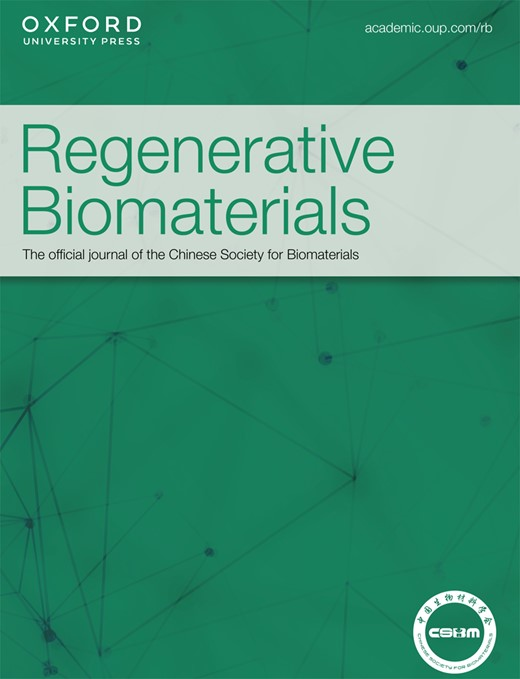钛种植体上的纤维拓扑结构促进了 pBMP2 激活基质的骨结合
IF 5.6
1区 医学
Q1 MATERIALS SCIENCE, BIOMATERIALS
引用次数: 0
摘要
钛(Ti)植入物在外科手术后被广泛使用。其表面的生物活性对于促进与周围骨组织的整合,最终确保植入物的稳定性和长期功能性非常重要。表面的质粒 DNA 激活基质(DAM)涂层有利于骨结合,但在进一步应用中仍受困于转染效果不佳,尤其是在体内实际条件下对骨髓间充质干细胞(BMSCs)的影响。在此,我们在纤维颗粒钛(FG Ti)表面构建了一种 DAM,由相变溶菌酶(P)作为粘合剂、富含阳离子精氨酸的脂质(RLS)作为转染剂以及用于表达骨形态蛋白 2(BMP-2)的 DNA 质粒(pDNA)组成。与商用试剂(Lipofectamine 2000 和聚乙烯亚胺)相比,阳离子脂质 RLS 对间叶干细胞的转染效果提高了 30 倍。更重要的是,Ti 表面拓扑结构不仅能促进 DAM 在间充质干细胞上达到较高的转染效率(75.7% 的阳性细胞),还能保留其对成骨细胞的接触诱导作用。经进一步探讨,FG Ti 上的纤维拓扑结构可促进基因转染的 pDNA 摄取,并通过细胞骨架重塑促进间充质干细胞的细胞迁移,诱导接触引导以增强骨整合。同时,阳离子 RLS 和粘合剂 P 都具有抗菌作用,对大肠杆菌(E. coli)和金黄色葡萄球菌(S. aureus)的抑制率高达 90%,粘附的微生物减少,细菌被破坏。最后,在大鼠股骨髁突缺损模型中,FG Ti-P/pBMP2 植入物通过高效的基因传递、一致的表面拓扑结构和更强的抗菌性能,实现了加速骨愈合的能力。本文章由计算机程序翻译,如有差异,请以英文原文为准。
Fibrous topology promoted pBMP2-activated matrix on titanium implants boost osseointegration
Titanium (Ti) implants have been extensively used after surgical operations. Its surface bioactivity is of importance to facilitate integration with surrounding bone tissue, and ultimately ensure stability and long-term functionality of the implant. The plasmid DNA-activated matrix (DAM) coating on the surface could benefit osseointegration but is still trapped by poor transfection for further application, especially on the bone marrow mesenchymal stem cells (BMSCs) in vivo practical conditions. Herein, we constructed a DAM on the surface of fibrous-grained titanium (FG Ti) composed of phase-transition lysozyme (P) as adhesive, cationic arginine-rich lipid (RLS) as the transfection agent, and plasmid DNA (pDNA) for bone morphology protein 2 (BMP-2) expression. The cationic lipid RLS improved up to 30-fold higher transfection than that of commercial reagents (Lipofectamine 2000 and polyethyleneimine) on MSC. And importantly, Ti surface topology not only promotes the DAM to achieve high transfection efficiency (∼75.7% positive cells) on MSC due to the favorable combination but also reserves its contact induction effect for osteoblasts. Upon further exploration, the fibrous topology on FG Ti could boost pDNA uptake for gene transfection, and cell migration in MSC through cytoskeleton remodeling and induce contact guidance for enhanced osteointegration. At the same time, the cationic RLS together with adhesive P were both antibacterial, showing up to 90% inhibition rate against Escherichia coli (E. coli) and Staphylococcus aureus (S. aureus) with reduced adherent microorganisms and disrupted bacteria. Finally, the FG Ti-P/pBMP2 implant achieved accelerated bone healing capacities through highly efficient gene delivery, aligned surface topological structure, and increased antimicrobial properties in a rat femoral condylar defect model.
求助全文
通过发布文献求助,成功后即可免费获取论文全文。
去求助
来源期刊

Regenerative Biomaterials
Materials Science-Biomaterials
CiteScore
7.90
自引率
16.40%
发文量
92
审稿时长
10 weeks
期刊介绍:
Regenerative Biomaterials is an international, interdisciplinary, peer-reviewed journal publishing the latest advances in biomaterials and regenerative medicine. The journal provides a forum for the publication of original research papers, reviews, clinical case reports, and commentaries on the topics relevant to the development of advanced regenerative biomaterials concerning novel regenerative technologies and therapeutic approaches for the regeneration and repair of damaged tissues and organs. The interactions of biomaterials with cells and tissue, especially with stem cells, will be of particular focus.
 求助内容:
求助内容: 应助结果提醒方式:
应助结果提醒方式:


